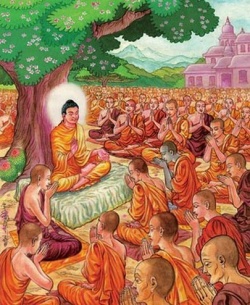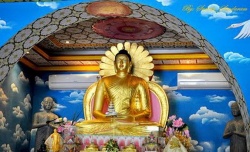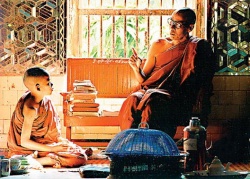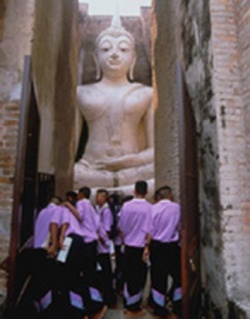Saṅkhāras versus Kamma (Saṃskāra vs. Karma)
Quick Overview of Sankharas (samskaras):
Sankharas: the mental formations that occur over time as one reacts similarly and consistently to a given stimulus. At the mental level, a stimulus (data) is received by one's eyes, ears, nose, mouth (taste), skin contact (touch), or memory of something. Once received, it is categorized as 'good' or 'bad' by one's mind. A sensation appears on one's body; either painful or pleasant. Finally, if one is not fully conscious, a reaction takes place due to this body-sensation- "I want it!" or "Get it away from me!".
Ex: If a person honks at you and cuts you off while driving, you may react with fear, swerving, and a 'bad' word thrown at them. Therefore, in future, a similar reaction pattern may occur due to these formations, unless they are 'broken'. Observation without reaction, prolonged observation during Vipassana Retreats and Sittings, and retraining one's mind with consciously positive comments can lessen and release sankharas.
When all sankharas are "burned off" in meditation, no more sensations- gross or subtle- will occur. Simply understandings and insight.
Sankharas and Kamma (Karma) are very different, yet similar...
Karma is any action, be it a thought, a word, or a deed. It acts to drop an energy of creation into life itself; like a droplet of water touching a flat surface of water, it's ripples will now carry and affect the whole pond. Our kammas (karmas), whether good or bad, our volitional actions, will create a ripple effect into life itself. Absolutely everything we do or say is a creation that begins an effect; just as a butterfly flapping its wings in Mexico affects the storms in the Indian Ocean..
For example, I may harm a person showing little emotional trauma in myself (the blocking of negative energy due to judgment or obsessive thought or fear or attachment for the issue) and this would provide me with few sankharas to release. Yet the karmic effect for me harming this person will create a large ripple in the pool of life. So you can begin to see how they are a little separate. Sakharas is connected moreso to continued mental habit pattern formations due to reactions and judgments and attachments which create energy patterns or pathways in our minds (in relationships, these patterns are known as 'codependency', for example).
Mogallana Example:
Mogallana, the Buddha's right hand man, was brutally killed in an ambush and died.
Why?
He was fully enlightened in his final life, possibly the 3rd most enlightened man during the time of the Buddha. So he no longer had any sankharas. He had no mental formations in his mind, no attachment, to deal with. So Sankharas are synonymous with mental karma. All his mental karma had been burned off. {As an aside, even an enlightened person must chop wood and carry water before, during, and after enlightenment, meaning, these mental formations (energy and codependency) are being created at all times and are constantly needing to be released/ burned off.}
However, with no sankharas, Mogallana was brutally beaten to death by a band of thieves who were hired to kill him. Minutes before his death, Mogallana was able to remotely communicate with the Buddha and share with him that he was about to die. He asked why this had happened. The Buddha responded that in lives past, Mogallana had killed his blind parents and robbed them in a staged ambush.
So this old karma, this old action, this old ripple in the pond of life, was finally coming full circle to be carried out as a burden on Mogallana's body. See, his mind was fully purified, yet his body had this lingering karma. Mind can always be fully purified, yet body, this denser aspect of ourselves, must still play out its karma.
The Law of Kamma is such that an action is made, and sometime in the unknown future, this action will bear fruit. It is unknown as to when.
The Buddha Example:
The Buddha was the most enlightened and moral man in existence 2600 years ago. Yet even with such purity and morality, higher than all gods in all realms, he had tremendous backaches in his later years. Sometimes he had to rest and ask Ananda to teach his discourses.
Why?
It is said that the Buddha had taken part in brutal 'gladiator-like' fights many many lifetimes beforehand, and his body had to now endure the pain he inflicted upon others during these fights.
Angulimala Example:
A student named Angulimala, upon encouragement from a teacher who sought revenge on him, had killed nearly 1000 men and women during the time of the Buddha. The Buddha, with his Divine Eye saw that Angulimala was about to kill another victim, so he set out to stop him. He caught up with Angulimala, and preached the Dhamma to him, who stood there covered in fingers and blood from his victims. A shred of clarity and consciousness returned in Angulimala, enough so that he recognized the error of his ways. He devoted his life to the Buddha and to enlightenment. Soon after, he became fully enlightened; he had burned off all his sankharas. Now he was only filled with pure love.
Angulimala dawned his robes and begged for alms like the other monks each day, humbly preaching the dhamma (dharma) to those who would listen to him. Yet to most places he would go, he was beaten until bloody and return to the monastery with blood covering his body. He would smile and resume his activity the following day.
Why?
Angulimala had fully released all mental reaction patterns (sankharas) from his mind; he was enlightened. Yet he had to reap the punishment and hatred of others for killing so many innocent people. In effect, his body had to undergo the karma of his actions.
The Buddha taught extensively about Karma (Kamma), and the lessons may bring you to tears by their beauty and profoundness. One audio from Dhamma Sukha is called, "Patience when physically wounded". It's amazing and shares much on the topic of kamma. If you have difficulty finding this audio, please contact Dhamma Sukha for a copy.
Sankharas, burning them off in retreats and during observation, etc, does wonders to balance our life-energy and purify our minds. It also does wonders for our Kamma. We do burn off much of our ripples by meditating and doing positive things to combat our past. Yet some remain, as we have all been on earth for many many lives.
Adding the components of Harmonious Communication (Right Speech) where we speak uplifting, uniting words to ourselves and to others at all times using Right Effort, as well as Harmonious Imaging (Right Thought) where we image ourselves in loving situations, doing harmonious things, praising others, etc, also does wonders for our Kamma .



